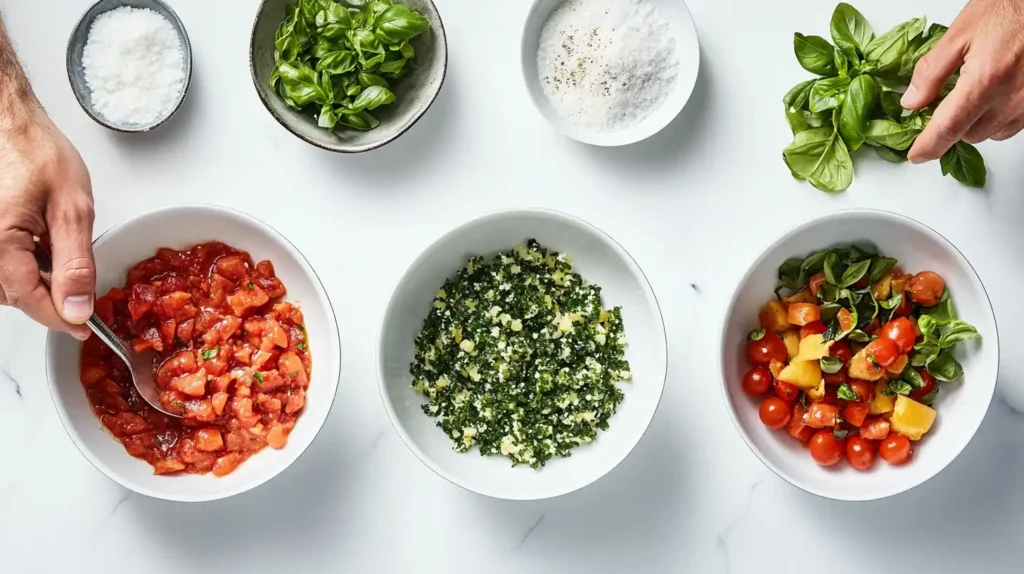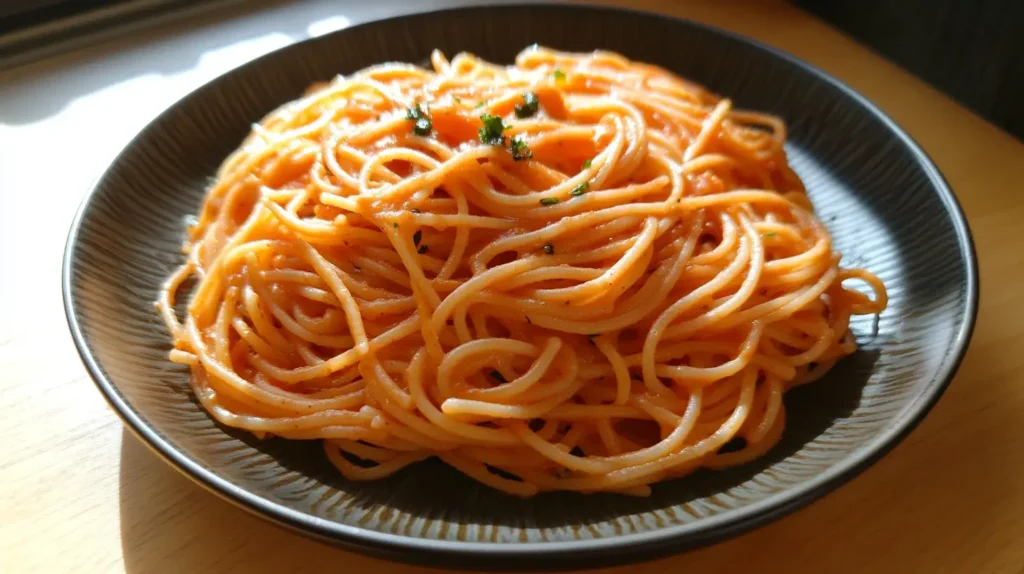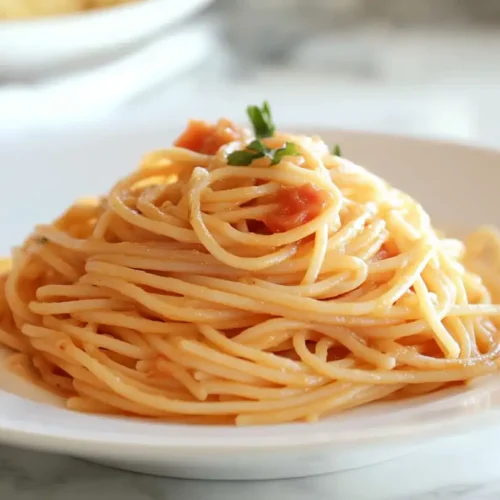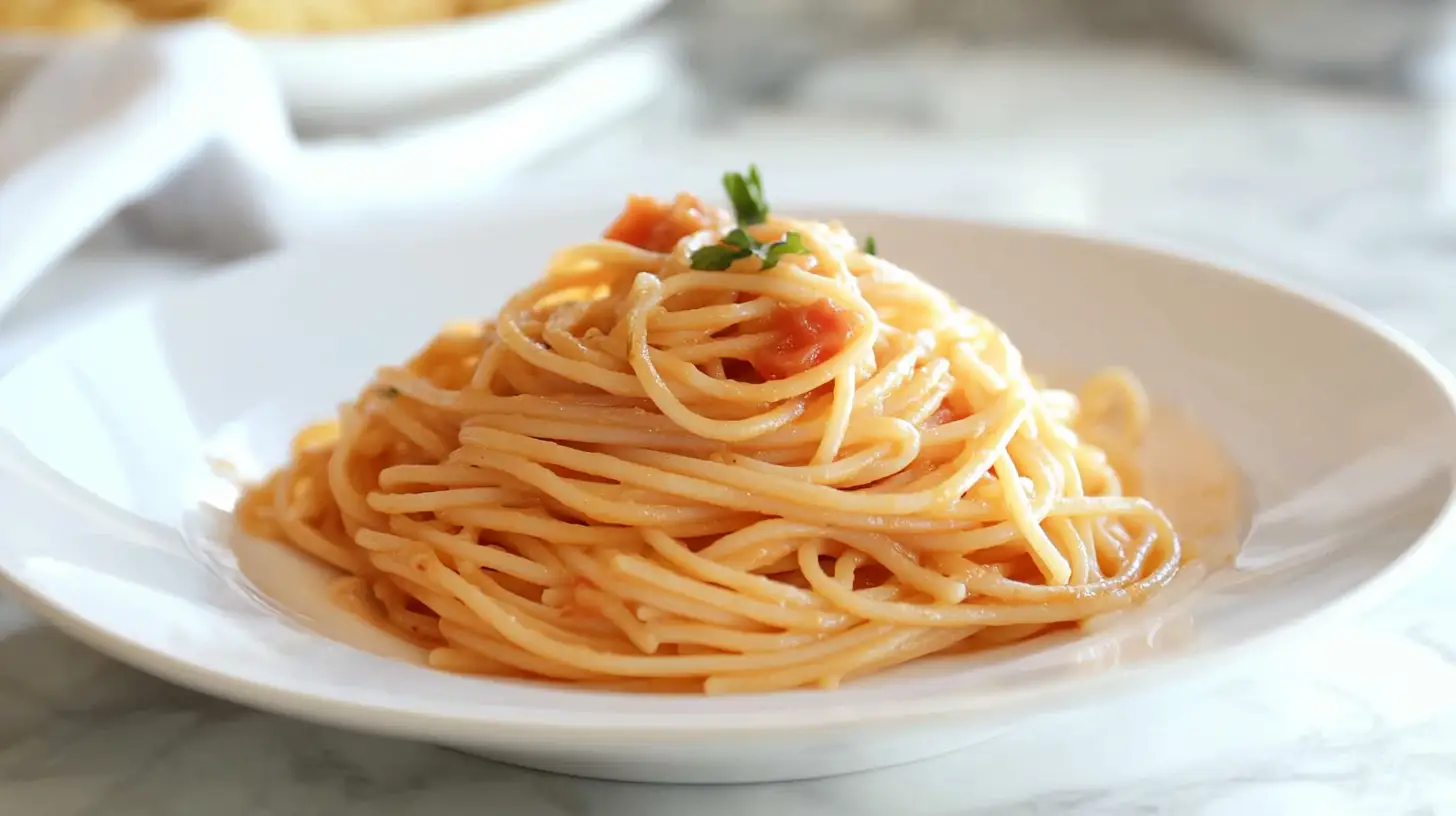Table of Contents
Blush sauce pasta is more than just a pretty plate—it’s comfort food with a splash of elegance. This creamy, tomato-based dish has taken over food blogs, dinner tables, and even romantic date nights for all the right reasons. With its smooth texture, rich flavor, and signature pink hue, it’s no wonder people are craving it by the forkful.
In this article, you’ll get the full scoop on what makes blush sauce pasta so special. We’ll cover everything from its origins and key ingredients to how it compares to other popular sauces. And yes, there’s a mouthwatering recipe in the mix too. Whether you’re a pasta lover or just pasta-curious, you’re in for a delicious ride.
What Is Blush Sauce Pasta Really?
A Saucy Definition: What Makes It ‘Blush’?
Blush sauce gets its name from the soft pink tint that forms when tomato sauce meets cream. Imagine a traditional marinara sauce that took a luxurious trip through a dairy spa—that’s blush sauce in a nutshell. It’s rich yet balanced, hearty but not heavy.
This sauce typically blends smooth tomato puree with half and half, butter, garlic, and parmesan cheese for depth. The result? A velvety pink sauce that clings lovingly to every pasta shape it touches.
But there’s more to it than just color. The blush in blush sauce pasta also refers to its mellow, slightly sweet flavor. It tones down the sharp acidity of tomatoes, giving the sauce a creamy roundness that’s simply irresistible.
Classic vs. Creative: How It’s Used in Italian-American Cooking
In Italian-American kitchens, blush sauce pasta is the go-to for weeknight dinners and date-night dishes. It’s versatile enough for a simple penne plate, but fancy enough to be served with fresh herbs and gourmet toppings.
Traditionally, it’s served with short pastas like:
- Penne or rigatoni (perfect for trapping the sauce)
- Farfalle for a fun, kid-friendly twist
- Tortellini if you’re in the mood for something indulgent
Want to dress it up? Add mozzarella pearls, sprinkle some fresh basil, or toss in grilled veggies for a wholesome spin.
Blush sauce is often confused with vodka sauce or rose sauce, but it has its own identity—especially when you skip the alcohol and focus on pure, creamy goodness. We’ll dive into those comparisons in the next part, so stay tuned.
Ingredients That Make the Magic
Core Components You Can’t Skip
When it comes to blush sauce pasta, the magic really starts with the ingredients. Even though the recipe is super simple, every element counts. Think of it like a love letter between tomato and cream—every line (or in this case, ingredient) adds emotion to the story.
Here’s what you absolutely need:
- Tomato sauce (smooth, not chunky)
- Half and half or heavy cream for that dreamy texture
- Butter, onion, and garlic as the flavor-building trio
- Parmesan cheese to add richness and depth
The trick is in how these ingredients interact. The tomatoes bring acidity, the cream softens it, and the cheese ties everything together with that savory kiss. It’s comfort food, but with a velvety touch.
Need a visual or want to compare options? Check out this creamy caramelized onion pasta that shares some of the same cozy vibes—it’s equally drool-worthy.
Optional Add-Ins That Upgrade Your Dish
Now for the fun part—customization. Once you’ve nailed the basics, you can mix and match extra flavors to keep things interesting. Want to make your blush sauce pasta extra special? Try these easy upgrades:
- Fresh basil or oregano for a herby lift
- Mini mozzarella balls that melt right into the sauce
- Chili flakes or a tiny bit of hot honey if you like it bold
- Sun-dried tomatoes for a sweet, chewy contrast
- Or even mushrooms and spinach for a veggie-rich twist
These additions don’t just taste great—they help the dish feel fresh every time. And if you’re cooking for picky eaters or trying to impress on date night, these swaps give you some serious pasta game.
Blush vs. Vodka vs. Rose – What’s the Difference?
Is Blush Sauce the Same as Vodka Sauce?
Here’s a question that pops up all the time—are blush sauce pasta and vodka sauce basically the same thing? The short answer is: almost, but not quite.
Both sauces start with a tomato and cream base. But vodka sauce specifically includes, well, vodka. It helps emulsify the cream and tomato mixture, creating an even silkier texture. Blush sauce, on the other hand, is more flexible. It may skip the alcohol altogether, or use something lighter like broth or halal white vinegar for flavor balance.
So if you’re avoiding alcohol for dietary or personal reasons, blush is your bestie. And guess what? You won’t miss a thing. The taste is still bold, rich, and perfectly balanced.
For another alcohol-free creamy tomato twist, check out this version from Simply Recipes on tomato cream sauce that skips the spirits but keeps all the flavor.
What Is the Pink Pasta Sauce Called?
You’ve probably heard it called pink sauce, rose sauce, or even tomato cream sauce—and honestly, they’re all kissing cousins. The names mostly refer to the same idea: combining red (tomato) and white (cream) to create a lovely blush tone.
The term rose sauce is more common in Canadian or French-influenced kitchens. Blush sauce is big in American-Italian homes. And pink sauce? Well, that’s what your kids will probably call it.
The bottom line? Whether you say rose, pink, or blush, you’re getting the same comforting combo that makes blush sauce pasta such a hit.
Recipe 🌟 – How to Make the Perfect blush sauce pasta
Introduction
If there’s one dish that feels like a warm hug in a bowl, it’s blush sauce pasta. With its silky pink sauce and soul-satisfying flavor, it’s the kind of meal that turns ordinary weeknights into something special. Whether you’re new to cooking or a seasoned pasta pro, this recipe brings restaurant vibes right into your kitchen—without the price tag or pressure.
Ingredients 🛒
Here’s what you’ll need for a batch that serves 4 hungry folks:
- 2 tbsp butter
- ½ medium yellow onion, finely chopped
- 3 garlic cloves, minced
- 28 oz smooth tomato sauce (canned works great)
- 1 tbsp tomato paste
- 1 cup half and half (or heavy cream for a richer texture)
- ½ cup grated parmesan cheese
- 1 tsp sugar (balances acidity)
- Salt and black pepper to taste
- Cooked pasta of choice (penne, rigatoni, or fusilli work best)
- Optional: fresh basil, red chili flakes, or mini mozzarella balls
Directions 👩🍳

Let’s cook this beauty step by step:
- Sauté the aromatics:
In a large pan, melt the butter over medium heat. Toss in the chopped onion and garlic. Stir often until everything softens and smells amazing—about 3 to 4 minutes. - Build the tomato base:
Pour in the tomato sauce and add the tomato paste. Stir until smooth. Let it simmer uncovered for 7 to 10 minutes so the flavors really concentrate. - Cream it up:
Reduce the heat to low. Stir in the half and half slowly while mixing. Add sugar and let the sauce simmer for another 5 minutes. - Cheese, please:
Stir in the parmesan cheese until it melts into the sauce. Season with salt and black pepper to taste. - Mix and match:
Toss in your cooked pasta and give it a good stir so every noodle is beautifully coated. - Final touches:
Want to elevate things? Top with basil, chili flakes, or melt-in-your-mouth mozzarella balls.
That’s it. Simple, right? In under 30 minutes, you’ve made blush sauce pasta that’s creamy, dreamy, and ready for seconds.
Tips & Variations 📌
- Dairy-free version? Use oat cream or unsweetened coconut cream—it still gives you that luscious texture.
- Low-carb swap? Zucchini noodles or chickpea pasta hold up great with this sauce.
- Flavor boost tip: Add a dash of onion powder or roasted garlic paste for deeper notes.
Chef’s tip: If you like a super-smooth texture, blend the sauce before adding pasta. Game-changer.
Blush Sauce Pairings You’ll Love
Best Pasta Types to Use
Not all pasta shapes are created equal, especially when you’re dressing them in blush sauce. You want something that holds the creamy sauce like a best friend hugs tight.
Here are top picks:
- Penne: The classic choice. Those little tubes trap the sauce beautifully.
- Rigatoni: Bigger tubes, bolder bite.
- Farfalle (bow-ties): Adds a fun visual twist and texture.
- Fusilli or rotini: Their spiral shape soaks up every drop.
Feeling fancy? Try blush sauce over stuffed ravioli or tortellini. It’s indulgence at its best.
Looking for more pasta inspiration? You’ll love this cavatappi pasta recipe that plays well with creamy sauces too.
Add Proteins or Veggies for Balance
Want to turn your blush sauce pasta into a full meal? Just toss in your favorite protein or veg combo. Here’s what works like a charm:
Proteins:
- Grilled chicken (classic and lean)
- Seared shrimp (adds a seafood flair)
- Roasted chickpeas (for a vegetarian crunch)
Veggies:
- Spinach (wilt it right into the sauce)
- Mushrooms (adds earthy depth)
- Broccoli or peas (for color and crunch)
It’s easy to mix and match, which is why this dish never gets old. No two bowls have to be the same—unless you want them to be!
Fun fact: In many Italian-American households, creamy tomato sauces like blush were weekend staples because they were easy to stretch and personalize for picky eaters.
Is Blush Sauce Worth the Hype?
Flavor Profile & Texture Explained
You might be wondering—what’s the big deal with blush sauce pasta? Why is it flooding TikTok, dinner tables, and foodie blogs alike? The answer is simple: flavor + feel. It’s the kind of sauce that hits all the right notes—tangy, creamy, savory, and slightly sweet—without trying too hard.
The texture is where blush sauce really shines. It’s not too thick, not too runny. It hugs the pasta like a cozy blanket, clinging to every curve and crease. You don’t get that with plain tomato sauce or overly rich Alfredo.
Think of it as the best of both worlds: the boldness of tomato sauce meets the comfort of cream-based sauces. No wonder it’s gained a cult following. According to a 2023 survey by the National Pasta Association, creamy tomato sauces like blush are among the top three choices for U.S. home cooks, especially for family dinners.
And the best part? It’s super customizable. You can add herbs, spice, proteins—or keep it plain for a crowd-pleasing classic.
What Makes It So Popular on TikTok & Food Blogs

Social media has a knack for turning humble recipes into viral sensations. And blush sauce pasta is no exception. One scroll through Instagram or TikTok, and you’ll see beautifully styled pasta bowls topped with mozzarella pearls and fresh basil leaves.
But it’s not just the looks. People love it because it’s easy, it feels fancy, and it tastes amazing. It’s the kind of recipe that makes you look like you know what you’re doing in the kitchen—even if you’re winging it.
Want to ride the creamy pasta trend even further? You might love this Marry Me Chicken Pasta—a romantic, flavor-packed spin on the classic.
Cooking Tips for Restaurant-Quality Results
Chef’s Tips for Better Blush Sauce Pasta
Want to make your blush sauce pasta go from good to unforgettable? Here are some quick, pro-level tricks you can start using tonight:
- Use room-temperature cream – Cold cream can curdle when it hits hot sauce. Let it warm up first.
- Don’t skip the sauté – That golden onion and garlic base adds depth you can’t fake.
- Grate your own parmesan – It melts smoother than pre-shredded.
- Undercook your pasta slightly – Let it finish cooking in the sauce to soak up more flavor.
Chef’s tip: If your sauce feels too thick, a splash of pasta water loosens it up beautifully and adds extra silkiness.
Avoid These Common Mistakes
Even though blush sauce pasta is beginner-friendly, a few missteps can dull its shine. Keep an eye out for these easy-to-avoid mistakes:
- Adding cream too early: It might break if your sauce is still too hot. Wait till the simmer’s done.
- Skipping seasoning: Tomatoes need salt to pop. Taste before serving and adjust if needed.
- Using chunky sauce without blending: You’ll lose the smooth finish that makes blush sauce so iconic.
Keep these tips in mind, and you’ll nail this dish every time. No second-guessing, just creamy, saucy bliss.
Blush Sauce for Special Occasions
Valentine’s Day or Weeknight Dinner?
Blush sauce pasta walks a beautiful line between everyday comfort and candlelight-classy. That soft pink hue, the creamy texture, the gentle garlic and tomato aroma—doesn’t it just feel romantic?
It’s no surprise that this dish makes frequent appearances on Valentine’s Day dinner menus. Just picture it: a heart-shaped bowl, mozzarella pearls peeking through the blush sauce, and fresh basil leaves for a pop of green. It’s a love letter, in pasta form.
But don’t be fooled—blush sauce pasta isn’t just for special nights. It’s also the perfect go-to when you want something quick, filling, and totally craveable on a Tuesday evening. It cooks fast, it tastes amazing, and it makes leftovers you’ll actually be excited to eat. That’s a win no matter what the calendar says.
Make-Ahead, Freeze & Reheat Tips
Planning ahead? You’re in luck. This sauce isn’t just flexible at dinnertime, it’s forgiving in the fridge too.
Here’s how to prep it like a pro:
- Make it in advance: Store blush sauce in an airtight container in the fridge for up to 4 days.
- Freezing tips: Let the sauce cool completely before freezing. Use freezer-safe containers and label them clearly. It’ll stay fresh for about 2 months.
- Reheating: Gently warm it on the stove over low heat, stirring often. Add a splash of water or milk to bring it back to life if it looks too thick.
Chef’s insight: Avoid freezing the sauce with pasta already mixed in. Reheat the sauce and cook fresh pasta for best results—trust us, it makes a difference.

Blush Sauce Pasta
Equipment
- Large Pan
- Pasta Pot
Ingredients
Blush Sauce
- 2 tbsp butter
- 0.5 medium yellow onion finely chopped
- 3 garlic cloves minced
- 28 oz smooth tomato sauce
- 1 tbsp tomato paste
- 1 cup half and half or heavy cream
- 0.5 cup grated parmesan cheese
- 1 tsp sugar
- salt and black pepper to taste
To Serve
- cooked pasta penne, rigatoni, or fusilli
- fresh basil, chili flakes, mini mozzarella balls optional toppings
Instructions
- Sauté butter, onion, and garlic in a large pan over medium heat for 3-4 minutes until soft.
- Add tomato sauce and tomato paste. Simmer uncovered for 7-10 minutes.
- Reduce heat and stir in half and half, sugar, and simmer for 5 minutes.
- Add parmesan cheese, season with salt and pepper.
- Toss cooked pasta into the sauce and mix well. Garnish with optional toppings and serve.
Notes
FAQs – Blush Sauce Pasta Questions Answered
What is blush sauce made of?
Blush sauce combines tomato sauce, cream (often half and half), garlic, onion, and parmesan cheese. It sometimes includes herbs, chili flakes, or even a bit of sweetener to balance acidity. The creamy tomato blend gives it that signature rosy glow.
Is blush sauce the same as vodka sauce?
Not quite. Vodka sauce includes actual vodka, which helps emulsify the cream and tomato, giving it a smoother texture. Blush sauce skips the alcohol but still delivers a rich, creamy profile. Both taste amazing, but blush sauce pasta is the more flexible and family-friendly option.
What is the pink pasta sauce called?
It’s often referred to as blush sauce, rose sauce, or simply pink sauce. They all describe the same idea: blending tomato sauce with cream to create a soft, pink-hued finish.
Is blush sauce the same as rose?
Yes! In most cases, blush sauce and rose sauce are used interchangeably. The names vary by region, but the recipe remains nearly identical—especially when alcohol is left out.
Still unsure? Watch a side-by-side visual comparison on YouTube’s pasta sauce breakdowns where chefs demonstrate the key differences in technique and texture.

